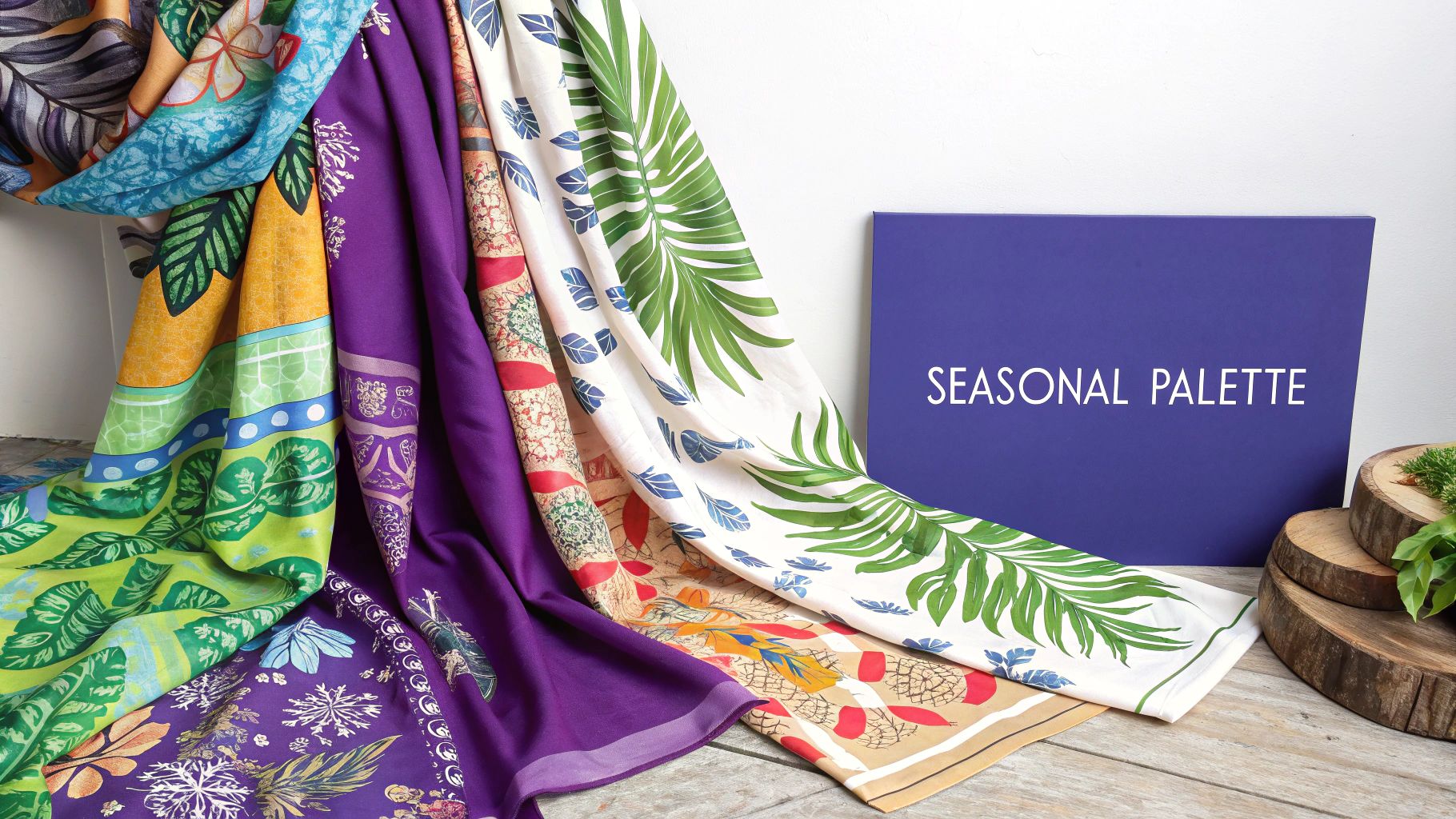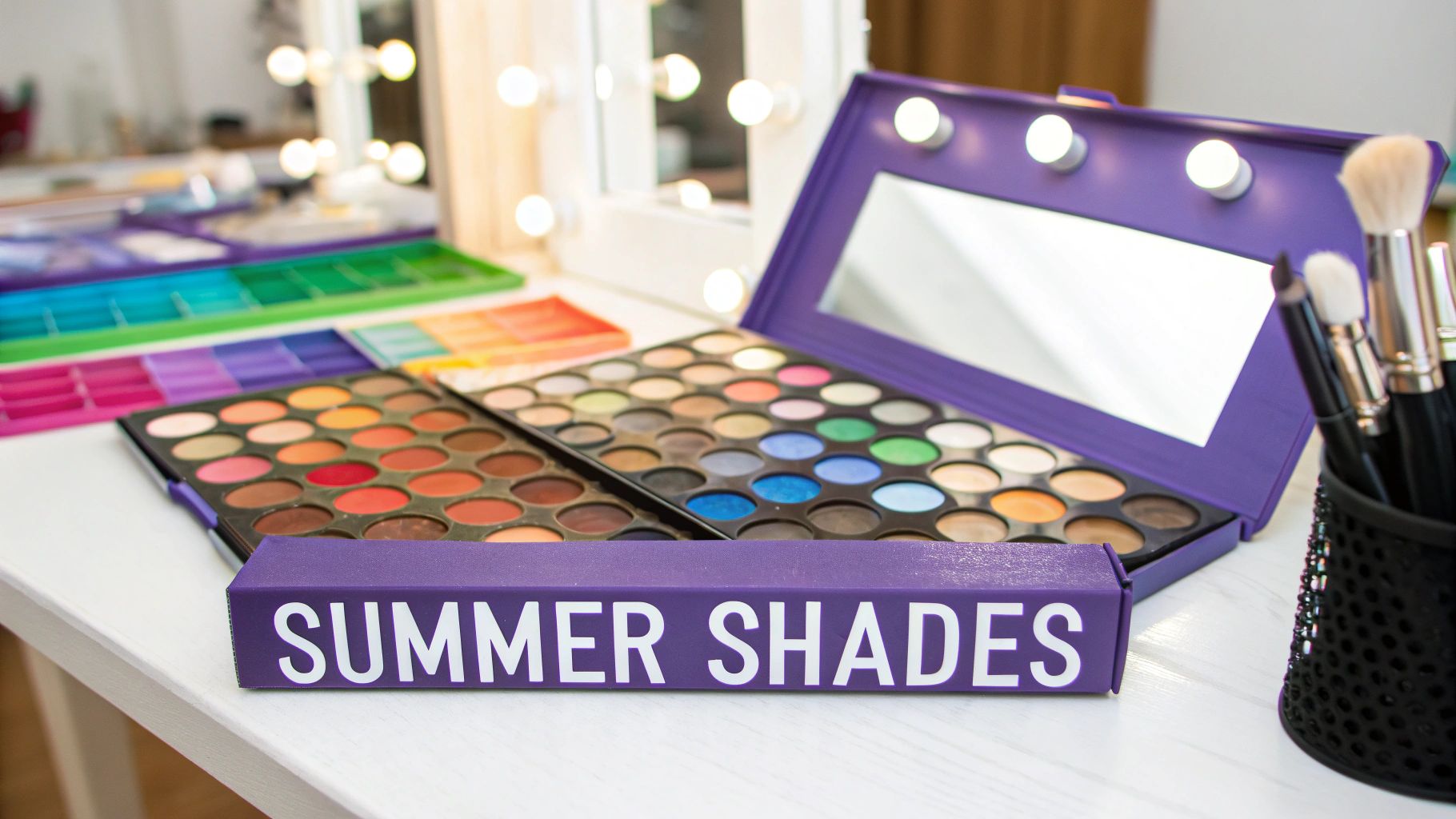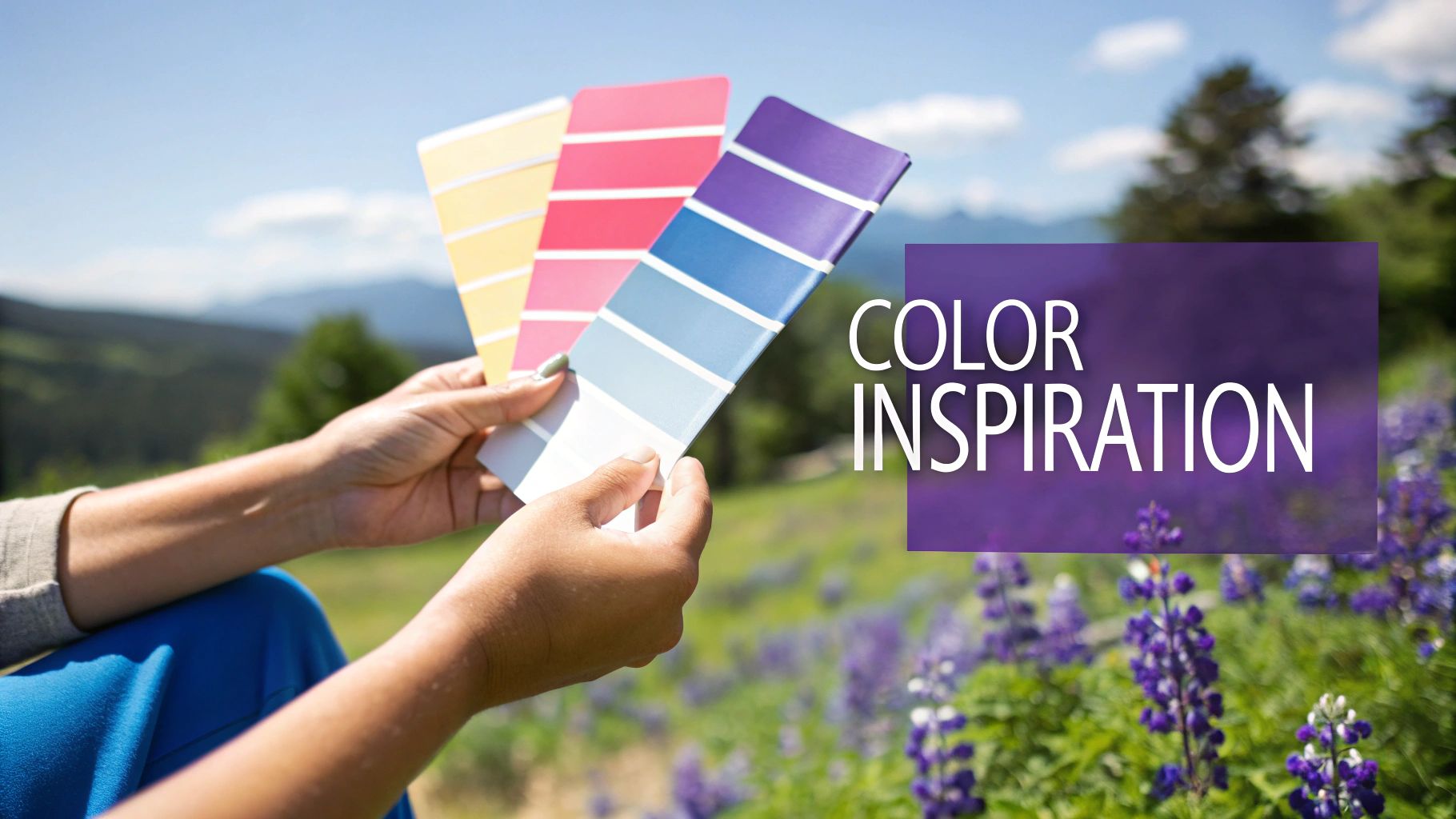
Summer Color Analysis: The Complete Guide to Finding Your Perfect Palette
By Emma Johnson - 8/16/2025
The Origins and Evolution of Color Analysis
Understanding how to choose colors that enhance our appearance has become essential for personal styling. The journey of color analysis from artistic concept to practical styling tool reveals how intuition and science came together to create the systems we use today.
The story begins in the early 20th century at the Bauhaus school in Germany. Johannes Itten, a key figure at Bauhaus, noticed something fascinating - his art students naturally preferred working with colors that matched their personal features. He split colors into "warm" and "cool" groups and saw clear connections between these groups and people's natural coloring. His observations set the foundation for modern summer color analysis and other seasonal color systems. Learn more about this historical development here.

From Art Theory to Practical Application
Color analysis first lived in art studios and design schools. But its potential for helping people make better styling choices soon became clear. This shift brought color theory out of academic settings and into everyday wardrobe decisions. Artists' insights began shaping how people chose their clothing colors.
The Development of Seasonal Color Systems
Building on Itten's work, experts created more detailed ways to match people with their best colors. The seasonal color analysis system sorts people into four categories: Spring, Summer, Autumn, and Winter. Each season represents specific colors that work well together. This approach made color analysis easier to understand and use. People could now take artistic color principles and apply them to their wardrobes.
Modern Advancements in Color Analysis
Technology has brought new precision to color analysis. AI-powered color analysis tools can now scan facial features and suggest ideal color palettes with remarkable accuracy. This digital approach offers convenient, personalized recommendations based on individual characteristics. As technology improves, color analysis keeps getting more precise and tailored to each person's unique features.
The Rise of Modern Seasonal Color Analysis
Seasonal color analysis, including summer color analysis, has seen renewed interest in recent years. This style system builds on principles established decades ago while adding modern approaches. The 1980s marked a major surge through companies like Color Me Beautiful and House of Colour, which applied theories from Johannes Itten and Robert Dorr to classify people into Winter, Spring, Summer, and Autumn groups. This made it simpler for people to select flattering colors for clothing and makeup. Learn more about the resurgence of color analysis.
Evolution of Techniques and Accessibility
While the basic principles remain unchanged, the methods for determining someone's season have advanced considerably. Early on, color analysis required expensive in-person consultations with limited availability. Now, technology has made this service more accessible to everyone.
Online tools and virtual consultations allow people to discover their best colors from home. The growth of educational content through blogs, videos and online communities has also empowered individuals to learn color theory independently.
The Role of Technology and Personalization
New tools like AI-powered analysis have improved the accuracy of color recommendations by detecting subtle variations in skin, hair and eye coloring that humans might miss. This data-driven approach leads to more precise results. Want to learn more? Check out this guide on understanding skin undertones.
Modern systems now recognize sub-categories within each season for more customized recommendations. For example, a "Light Summer" receives different color suggestions than a "True Summer" or "Soft Summer," ensuring the palette truly matches their unique features.

Impact on Confidence and Style
The core purpose of color analysis remains helping people look and feel their best. Understanding which colors enhance natural features allows for creating a more flattering wardrobe. This often leads to increased confidence, more efficient shopping, and a stronger sense of personal style. These positive effects on self-image continue driving interest in seasonal color analysis.
Mastering Summer Color Characteristics

The Summer color season brings to mind soft, ethereal qualities - think misty mornings and filtered sunlight. This palette features muted, cool-toned colors that work in harmony with specific natural features. Learning these key characteristics helps unlock the full benefits of Summer colors.
Decoding the Summer Complexion
The defining trait of Summer complexions is their cool undertones. While skin tones can range from light porcelain to medium beige, they all share a rosy or bluish base. This coolness is what sets Summers apart from the warmer seasons. The overall effect is gentle and refined, without stark contrasts.
The Subtleties of Summer Hair
Summer hair colors mirror the soft quality of the overall palette. Common shades include ash blonde, cool brown, and soft black. Unlike the golden blondes or rich auburns of other seasons, Summer hair has ashy, cool tones that blend naturally with the skin's undertones. A classic example is cool brunette hair with subtle gray highlights.
The Eyes Have It: Summer Eye Colors
Summer eyes add to the overall soft impression. Typical colors include blue-gray, muted green, or cool hazel - all with a distinctly cool tone. This creates a natural balance with the hair and skin. Even when Summer eyes are darker brown or deep blue, that characteristic cool undertone remains constant.
Navigating Summer Subtypes: Light, True, and Soft
Summer types often fall into three main categories: Light Summer, True Summer, and Soft Summer. Each reflects different aspects of the cool spectrum, from bright and clear to soft and muted. Color analysis helps identify these subtle variations, allowing for more precise color choices. By understanding these nuances, you can select shades that truly enhance your natural coloring.
Why Summers Are Sometimes Mistyped
The delicate nature of Summer coloring can lead to confusion. Light Summers might be mistaken for Springs, while Soft Summers can be confused with Autumns or Winters. The key is always the cool undertone - it's essential to look closely at the skin's natural coolness for accurate typing. This careful observation makes the difference between basic and precise color analysis.
The Complete Summer Color Palette Guide

Summer colors create a uniquely soft and elegant color palette. If you fall into the Summer season, you'll find a beautiful range of cool-toned, muted shades that work in harmony with your natural coloring. Let's explore the key aspects of Summer colors and how to use them effectively.
Understanding Summer Undertones and Saturation
The essence of summer color analysis comes down to cool undertones - typically blue or rosy in nature. These create a gentle, muted quality even in brighter colors. A Summer pink appears as a soft rose rather than a bright coral. The saturation levels in Summer colors are deliberately softer, similar to a watercolor painting where colors blend delicately rather than boldly standing out.
Exploring the Core Summer Color Palette
The Summer palette features colors that create a sense of refined beauty:
- Soft blues: Powder blue, sky blue, periwinkle
- Muted pinks: Rose pink, dusty rose, mauve
- Gentle greens: Seafoam green, sage green, mint green
- Cool neutrals: Light gray, soft beige, lavender-gray
When worn by someone with Summer coloring, these shades create a naturally flattering effect. Want to learn more? Check out How to master the importance of eye and hair color in personal color analysis.
Light Summer, True Summer, and Soft Summer: Decoding the Subtypes
The Summer season includes three main categories - Light Summer, True Summer, and Soft Summer. Each has distinct qualities:
Light Summers: Have the fairest coloring with very light skin and hair. They look best in the lightest, clearest Summer shades.
True Summers: Show balanced Summer traits with medium contrast. They can successfully wear most Summer colors.
Soft Summers: Display the most muted coloring. Their most flattering choices are the softest, grayest Summer shades.
Applying Summer Colors to Your Wardrobe and Makeup
Once you know your Summer subtype, you can thoughtfully select clothing, accessories and makeup. Focus on colors that complement your specific variation of Summer coloring.
Consider a Light Summer choosing a powder blue top with a light gray skirt, while a Soft Summer might prefer a mauve dress paired with a lavender-gray sweater. Selecting the right shades makes summer color analysis work for you.
Making Current Trends Work with Summer Colors
You can stay on-trend while honoring your Summer palette. The key is finding fashionable pieces in Summer-appropriate colors or incorporating current styles in your best shades. Summer color analysis helps you make confident style choices that look naturally beautiful on you.
Building Your Ultimate Summer Wardrobe
After learning about your Summer color palette, the next step is creating a wardrobe that makes the most of your colors. This is more than just shopping - it's about building a collection that works together and helps you look and feel your best. See more at: How to master your perfect color palette.
Assessing Your Current Wardrobe
Begin by going through your existing clothes. Take everything out and group items based on how well they match your Summer colors. This process helps you see what's working and what isn't. You might be surprised to find pieces that already fit perfectly into your Summer palette.
- Keep: Items that match your Summer colors perfectly
- Maybe: Pieces that could work with the right styling or changes
- Donate/Sell: Items that don't work with your Summer colors
Identifying Key Pieces and Strategic Purchases
After sorting your clothes, look for gaps in your wardrobe. Are you missing basic tops or pants in your best colors? Do you need more statement pieces in your signature shades? This helps you shop with purpose and avoid random purchases. Focus on creating a core collection of items that mix and match easily.
- Basic essentials: Light gray pants, soft pink blouse, seafoam cardigan - pieces that combine easily
- Eye-catching items: A periwinkle dress or mint blazer to brighten your look
- Smart accessories: Scarves, jewelry, and bags in Summer shades to update your outfits
Building a Versatile Wardrobe Across Seasons
Summer colors work year-round when you know how to style them. Your light and cool palette can adapt to any season through smart layering and color combinations.
- Mix with neutrals: Pair Summer-colored tops with navy blazers or gray cardigans
- Play with texture: Choose knits, corduroy, and velvet in Summer shades for cooler months
- Use deeper tones: Pick dark Summer colors like navy, teal, and burgundy in winter
Real-World Examples and Expert Advice
Color experts recommend that Summer types build around light neutral shades - soft gray, light beige, and lavender-gray. These colors form a base for brighter Summer tones like powder blue, rose pink, and seafoam green. A light gray suit with a rose blouse creates a polished work look, while a beige dress with a periwinkle scarf adds just the right pop of color. By learning to blend these shades, you can build a wardrobe that's practical and beautiful.
Advanced Summer Color Techniques and Applications
Now that you understand the basics of the Summer palette, let's explore practical applications to elevate your style. Learning how to use your colors strategically across makeup, hair color, and different situations helps create a cohesive and flattering look.
Mastering Makeup for the Summer Palette
The right makeup enhances your natural Summer features beautifully. Start with a foundation that matches your cool undertones, avoiding any yellow or warm tones. For cheeks, soft rose or dusty pink blushes add a natural flush. Eyes pop with cool-toned lavenders, blues and grays. Define eyes with taupe or gray liner rather than harsh black. Complete the look with muted rose, berry or soft pink lipstick.
Hair Color Harmony for Summers
Your hair color choice can make or break your Summer palette. The most flattering options include ash blonde, cool brown, and soft black - all with cool undertones that complement Summer coloring. For example, True Summers look great with cool medium brown hair accented by subtle ash highlights. Stay away from golden or warm tones that clash with your natural features.
Adapting Your Palette: Lighting, Seasons, and Occasions
While your Summer colors remain consistent, you can adjust how you use them. Warm artificial lighting calls for slightly deeper shades to prevent looking washed out. In winter, pair Summer colors with rich navy or charcoal gray. For formal events, choose shimmering versions of your best colors - a silvery-lavender evening gown makes more impact than a plain lavender top.
Incorporating Trends While Staying True to Your Colors
You can still embrace trends as a Summer - just translate them into your palette. When bright orange is popular, opt for a soft muted coral instead. This lets you participate in trends while ensuring they work with your natural coloring. Think of it as interpreting current styles through your unique Summer lens.
Advanced Color Combining for Summers
Take your color combinations to the next level with the 60-30-10 rule: Use 60% of your outfit in a main Summer color like soft blue, 30% in a complementary color like rose pink, and 10% in an accent like silver. This creates visual interest while maintaining harmony. You can also play with different tints and shades within your palette for depth.
Ready to unlock the full potential of your Summer colors? AI Color Analysis provides personalized color recommendations using advanced technology. Upload your photo for an instant custom PDF report with your ideal colors and style advice. Visit AI Color Analysis to discover your perfect palette.
Take your style to the next level with a professional analysis
You already know the theory. Now discover exactly which colors and styles enhance your personal image.
Loading...
Complete PDF report in less than 5 minutes
Your color season and personalized palette
Specific makeup and clothing recommendations
Based on professional color analysis
One-time investment:
One-time payment, no subscriptions. Instant access.